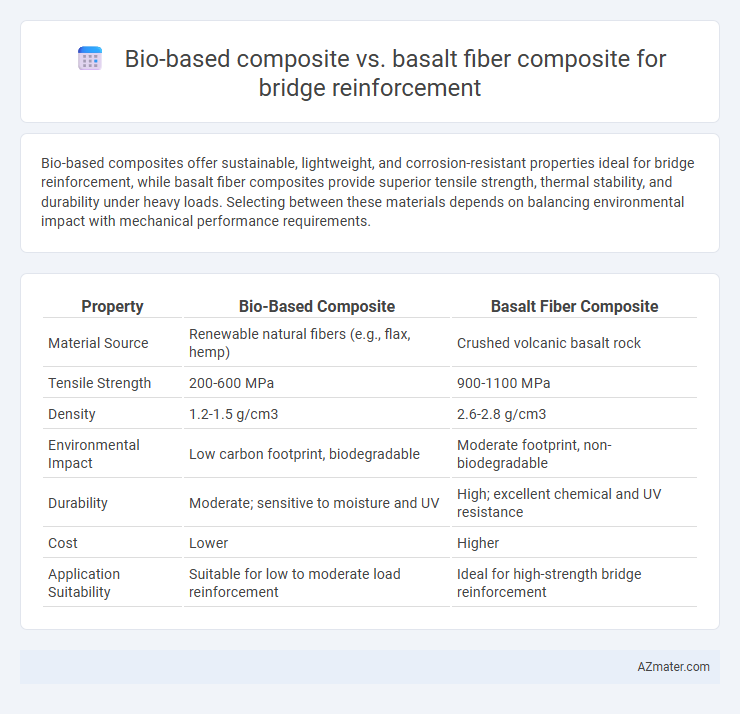Bio-based composites offer sustainable, lightweight, and corrosion-resistant properties ideal for bridge reinforcement, while basalt fiber composites provide superior tensile strength, thermal stability, and durability under heavy loads. Selecting between these materials depends on balancing environmental impact with mechanical performance requirements.
Table of Comparison
| Property | Bio-Based Composite | Basalt Fiber Composite |
|---|---|---|
| Material Source | Renewable natural fibers (e.g., flax, hemp) | Crushed volcanic basalt rock |
| Tensile Strength | 200-600 MPa | 900-1100 MPa |
| Density | 1.2-1.5 g/cm3 | 2.6-2.8 g/cm3 |
| Environmental Impact | Low carbon footprint, biodegradable | Moderate footprint, non-biodegradable |
| Durability | Moderate; sensitive to moisture and UV | High; excellent chemical and UV resistance |
| Cost | Lower | Higher |
| Application Suitability | Suitable for low to moderate load reinforcement | Ideal for high-strength bridge reinforcement |
Introduction to Bridge Reinforcement Materials
Bridge reinforcement materials include bio-based composites and basalt fiber composites, each offering distinct advantages for structural enhancement. Bio-based composites provide sustainability benefits through renewable resources and reduced carbon footprint, while basalt fiber composites deliver superior mechanical strength, durability, and resistance to environmental degradation. Selection between these materials depends on factors like load requirements, environmental conditions, and long-term performance needs in bridge infrastructure projects.
Overview of Bio-Based Composites
Bio-based composites for bridge reinforcement consist of natural fibers such as flax, hemp, or sisal embedded in bio-resins, offering environmentally sustainable and lightweight alternatives to traditional materials. These composites exhibit excellent corrosion resistance and biodegradability while maintaining adequate mechanical strength for structural applications. Their lower carbon footprint compared to basalt fiber composites makes them an attractive option for green infrastructure projects.
Overview of Basalt Fiber Composites
Basalt fiber composites, derived from volcanic basalt rock, offer exceptional mechanical strength, corrosion resistance, and thermal stability, making them ideal for bridge reinforcement applications. These composites exhibit superior durability and environmental resilience compared to traditional materials like steel and even bio-based composites, ensuring long-term structural integrity. Their lightweight yet robust nature reduces load on bridge components while providing excellent bonding with concrete, enhancing overall performance and longevity.
Mechanical Properties Comparison
Bio-based composites exhibit lower tensile strength and modulus compared to basalt fiber composites, which offer superior mechanical properties such as higher tensile strength (up to 3,500 MPa) and Young's modulus (around 90 GPa), making basalt fibers more suitable for heavy-load bridge reinforcement. Basalt fiber composites demonstrate better impact resistance, increased durability, and enhanced fatigue performance under cyclic loading conditions essential for bridge structures. While bio-based composites provide environmental benefits and moderate mechanical strength, basalt fibers ensure improved structural integrity and longer service life in demanding reinforcement applications.
Durability and Environmental Resistance
Bio-based composites exhibit excellent environmental resistance with superior biodegradability and corrosion resistance, making them suitable for sustainable bridge reinforcement applications. Basalt fiber composites offer exceptional durability against chemical attacks, UV radiation, and temperature fluctuations, ensuring long-term structural integrity in aggressive environments. Both materials enhance bridge reinforcement, but basalt fibers typically provide greater mechanical strength and longevity under harsh conditions compared to bio-based composites.
Sustainability and Eco-Impact
Bio-based composites for bridge reinforcement offer significant sustainability advantages due to their renewable raw materials and lower carbon footprint compared to basalt fiber composites, which rely on energy-intensive mineral extraction. The biodegradability and reduced environmental impact of bio-based composites contribute to eco-friendly construction practices, whereas basalt fiber composites provide superior durability but involve higher embodied energy and limited recyclability. Life cycle assessments highlight bio-based composites as preferable for minimizing ecological damage, promoting circular economy principles in infrastructure development.
Cost Analysis and Economic Feasibility
Bio-based composites generally offer lower material costs due to renewable raw materials and lower energy-intensive production processes compared to basalt fiber composites, which involve more complex manufacturing and higher raw material costs. Economic feasibility studies often highlight bio-based composites as more cost-effective for small to medium-scale bridge reinforcement projects, while basalt fiber composites, despite higher upfront costs, provide superior durability and lifecycle benefits that may justify investment in large-scale infrastructure. Lifecycle cost analysis balancing initial expenditure, maintenance, and service life critically influences the selection between bio-based and basalt fiber composites for bridge reinforcement applications.
Installation and Workability
Bio-based composites offer lightweight characteristics and enhanced flexibility, enabling easier handling and installation on irregular bridge surfaces compared to basalt fiber composites. Basalt fiber composites provide higher stiffness and superior durability but require specialized equipment and skilled labor during installation, which can increase project time and costs. Workability of bio-based composites often allows for quicker curing times and adaptability in field conditions, optimizing labor efficiency in bridge reinforcement applications.
Case Studies and Real-World Applications
Bio-based composites and basalt fiber composites have both demonstrated effective reinforcement capabilities in bridge engineering, with case studies highlighting their distinct advantages. Projects such as the rehabilitation of the Delaware Memorial Bridge utilized basalt fiber composites for superior tensile strength and corrosion resistance, resulting in enhanced structural durability under harsh environmental conditions. In contrast, bio-based composites, employed in pedestrian bridge applications like the Eco-Bridge in Sweden, showcased sustainable benefits with adequate load-bearing performance and reduced environmental impact, supporting eco-friendly infrastructure development.
Future Trends and Research Directions
Future trends in bridge reinforcement emphasize the integration of bio-based composites due to their sustainability, reduced carbon footprint, and biodegradability compared to basalt fiber composites, which are valued for superior mechanical strength and durability. Research directions prioritize enhancing the hybridization of bio-based fibers with basalt fibers to leverage combined benefits, improve long-term performance under diverse environmental conditions, and develop cost-effective manufacturing techniques. Advances in nanomaterials and polymer matrices aim to optimize interfacial bonding, increase load-bearing capacity, and extend the lifespan of reinforced bridge structures.

Infographic: Bio-based composite vs Basalt fiber composite for Bridge reinforcement
 azmater.com
azmater.com